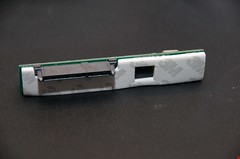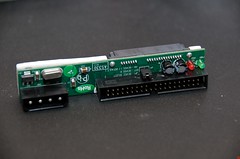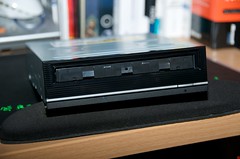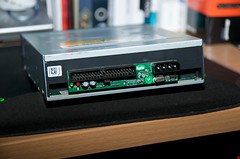Wow. Just got through possibly the worst coverage of Macworld I have ever seen. One can see that Steve Jobs is truly the dynamic force behind the scenes in Cupertino. To wit: No Steve = No live video feed No Steve = No Snow Leopard update No Steve = No Blu-ray support announcement No Steve = No Mac Mini refresh No Steve = No netbook sized MacBook (MacBook Mini? MacNote?) No Steve = No vid card refresh for Mac Pro No Steve = No Cinema Display refresh Top that all off with MacRumors' live coverage getting hacked ("STEVE JOBS JUST DIED" was inserted into their comment stream by person(s) unknown) and then their site went down. Now, don't get me wrong, I know better than most people how dangerous anything happening to the pancreas is (I am a survivor of necrotizing pancreatitis - which has a 2% survival rate in 1 month vs, pancreatic cancer's 20% the first year), and I do not begrudge Mr. Jobs looking after his health. It just without Steve, Apple loses quite a bit of its zing. On a positive note, two new MacBook Pro models were introduced and the 17-inch unit looks amazing. I am going to have to head over to my favorite Apple store to get a gander at one. The thinness and high-gamut display bode well for photographers in the field, especially with photographer-centric Windows laptops already on the market (expect my review of the Lenovo W700 this week). The new iLife and iWork are worthy upgrades considering the amount of utility people get for the price and I am glad to see that Apple finally realizes that there is more to the net than MobileMe.
Tuesday, January 6, 2009
Wednesday, September 10, 2008
Interarchy and Iris: Two from Nolobe Software

 Interarchy is one of the slickest file transfer programs I have ever had the pleasure of working with. Unlike most other file transfer application which use local and remote file viewing panes, Interarchy shows only the remote content, the local content is displayed in the Finder as usual. That’s right, the Interarchy window behaves as any other window on the Mac desktop. This ease of use can be an issue for veterans of classic file transfer applications (like me - something so obvious, isn’t).
While it gets top marks in protocol support, features and interface design, actual file transfers do not live up to the hype. File transfer speeds on this app are good, but not impressive. Nolobe claims that the only limit to this application’s transfer speed is the underlying speed of the hard drive and networking subsystems. I transferred a 700 MB AVI file from my desktop to a local FTP server over gigabit ethernet and it took 3:32s. The same file transferred using CuteFTP Mac Pro took only 2:24s.
Interarchy is one of the slickest file transfer programs I have ever had the pleasure of working with. Unlike most other file transfer application which use local and remote file viewing panes, Interarchy shows only the remote content, the local content is displayed in the Finder as usual. That’s right, the Interarchy window behaves as any other window on the Mac desktop. This ease of use can be an issue for veterans of classic file transfer applications (like me - something so obvious, isn’t).
While it gets top marks in protocol support, features and interface design, actual file transfers do not live up to the hype. File transfer speeds on this app are good, but not impressive. Nolobe claims that the only limit to this application’s transfer speed is the underlying speed of the hard drive and networking subsystems. I transferred a 700 MB AVI file from my desktop to a local FTP server over gigabit ethernet and it took 3:32s. The same file transferred using CuteFTP Mac Pro took only 2:24s.

Posted by
Carlos Echenique
at
12:30 AM
View Comments
![]()
![]()
Saturday, July 26, 2008
Dropbox: Practical Web 2.0
Web 2.0 is the buzzword for the next generation of web applications that interact directly with users at the system level. The term has been bandied about for the last couple of years but no one has really developed anything that crystallizes the idea. Until now.
The folks at Dropbox have come up with a novel way to solve an age-old Internet problem: secure file sharing with yourself, your friends and family.
By combining web services, Amazon's S3 storage clusters and some clever programming, Dropbox plugs into Windows Explorer and Mac Finder to create a drag-and-drop interface for easy file sharing. Create shared folders between yourself and your friends/family, drop files in and a Mac-like sync occurs between all parties involved. Have to collaborate with a group of people? Add names to the share folder and when you drop the file in there, all participants get a copy.
about for the last couple of years but no one has really developed anything that crystallizes the idea. Until now.
The folks at Dropbox have come up with a novel way to solve an age-old Internet problem: secure file sharing with yourself, your friends and family.
By combining web services, Amazon's S3 storage clusters and some clever programming, Dropbox plugs into Windows Explorer and Mac Finder to create a drag-and-drop interface for easy file sharing. Create shared folders between yourself and your friends/family, drop files in and a Mac-like sync occurs between all parties involved. Have to collaborate with a group of people? Add names to the share folder and when you drop the file in there, all participants get a copy.
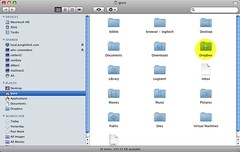
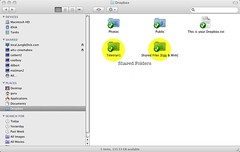
Posted by
Carlos Echenique
at
10:54 PM
View Comments
![]()
![]()
Saturday, June 28, 2008
Mac Pro SATA Blu-Ray HOWTO
Apple's decision to not offer a Blu-Ray drive as an option on the Mac Pro has been frustrating many users for quite some time. PC users have long enjoyed the expanded storage and high-definition content available on the new format.
This has not stopped enterprising third parties from adding Blu-Ray drives to their systems. The good news is that Apple decided to make the Mac Pro easy to upgrade in the field. The bad news is that Apple chose to use the more traditional (and less expensive) IDE (PATA) interface for it's optical drives. PC motherboard OEMs are cramming more and more SATA ports on their boards, so optical drive makers are switching to SATA as well. This makes it hard to find IDE based Blu-Ray drives.
Enter the gang at Cooldrives.com with their SATA-PATA adaptor board. This little gem plugs into the back of the SATA Blu-Ray drive and allows you to easily install it in the Mac Pro. Apple provides a complete and thorough set of instructions on how to swap out optical drives on the Mac Pro, so I won't cover those here.
SATA and PATA sides of the Cooldrives adaptor board
Here are the steps to prepare any SATA optical drive for installation in the Mac Pro using Apple's instructions.
Tools needed:
- Large paperclip
- Small Phillips screwdriver (or large jeweler's screwdriver)
- Tweezers (optional)
Instructions
- Take the large paperclip and unfold one side of it.
- Insert the unfolded end of the paperclip in the front of the optical drive to manually pop out the drive tray. (Please refer to the drive manual to see the exact location of the ejection port.)
- Turn the drive over and (using your fingers only) pry the front plate off of the drive tray. The plate is usually snapped on the front of the tray, so carefully pry the tabs away from the tray and push down. The front plate should slide off intact.
- Take the Cooldrives adaptor and peel the cover off of the double-sided tape.
- Line up the SATA connector with the SATA port on the optical drive.
- Press the Cooldrives adaptor gently but firmly onto the optical drive.
- If you are installing the drive as the Mac Pro's primary optical drive (as I did), you have to pull the jumper off of the back of the adaptor board. Use your fingers or the tweezers to pull the jumper. If the drive is going into the secondary slot, you won't have to mess with the jumper. (Apple usually expects optical drives to be set to "Cable Select" but that is not an option on the Cooldrives adaptor.)
Your drive should now look like this:
Front and back views of prepared optical drive
Follow the Apple installation guide and you will be able to mount the drive easily in your Mac Pro. I used an LG GGW-H20L which supports BD writing, HD-DVD reading, multi-layer discs, DVD's, CD's and includes BURN-Proof and Lightscribe. You can purchase this drive from Performance PC's. Tell Hank that I sent you.
Please keep in mind that Blu-Ray/HD-DVD playback is not supported in any Mac OS yet (the jury is still out on Snow Leopard) so you won't be able to play commercial discs. You will be able to burn BD discs for playback on set top players and for data storage. Roxio Toast Titanium 9 offers BD support via an optional plugin.
Posted by
Carlos Echenique
at
2:18 PM
View Comments
![]()
![]()
Sunday, March 16, 2008
Moving back to Mac: Fun with networked printers
As my little journey continued, I began connecting my Mac to the Windows network  that already exists in my home. I was already connected to the IP network, so I tested the waters hooking up networked printers and connecting to shared drives.
that already exists in my home. I was already connected to the IP network, so I tested the waters hooking up networked printers and connecting to shared drives.


Posted by
Carlos Echenique
at
11:22 PM
View Comments
![]()
![]()
Labels: epson r800, gutenprint, leopard, mac, printing
Wednesday, February 20, 2008
HD Format Wars are over, but who won?
The war over which high-definition disc format to choose is now over. Toshiba yesterday announced that it would be withdrawing it's HD-DVD players from the market and retiring the format. With Warner Brothers deciding to release it's content on Blu-Ray Toshiba seems to have gotten the message. So, Sony is the winner, right? Maybe.
Posted by
Carlos Echenique
at
10:45 AM
View Comments
![]()
![]()
Labels: consumer electronics, format war, HD, mac, PC
Tuesday, February 5, 2008
Apple Blu-Ray Support: What's taking so long?

I have been thinking about this topic for quite some time now. What is preventing Apple from officially supporting BD drives and HD content from them? Steve Jobs is on the Blu-Ray Steering Committee for Pete's sake!
Not technology. With the latest refresh of the Mac Pro, even the base model has hardware support for decoding the HD content with ease. MacBooks and iMacs have been that way for a while as well.
Not encryption. The HDCP stack is now supported fully by all of the components.
Not licensing. iTunes/AppleTV already has access to a ton of HD content.
The only answer (that I can think of) is money. Playing HD content over DVI or HDMI requires royalty payments to the patent owners. My guess is that Steve is waiting for DisplayPort (the royalty-free VESA standard for HD connectivity) to become prevalent. He will then announce new video card options for the upgradeable Macs and new version of the MacBook to support this technology. At this point the drives will become suddenly available and viewing BD content on the Mac will only require a quick software update (which removes the blocks in place).
Oddly enough the catalyst for this will be Windows Vista. With the release of Service Pack 1, Microsoft will add support for UEFI (making more video cards compatible with Mac) and DisplayPort as well. This will drive changes in the video industry with new graphics cards and displays coming out in force later this year. Add HP throwing their weight in the UEFI arena and we can see a lot more options for the Mac in the near future.
